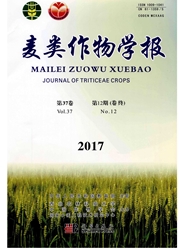

 中文摘要:
中文摘要:
为给华北地区冬小麦节水高产高效栽培提供理论依据,选用当地两个主栽冬小麦品种济麦22和石麦15为材料,在大田春灌一水(W1)和春灌二水(W2)2个灌水条件下均设置192kg.hm-2(N1)和270kg.hm-2(N2)2个施氮水平,研究了在水氮限量供给下冬小麦氮素吸收利用特征。结果表明:(1)在W1水平下,济麦22籽粒产量N1与N2处理无显著差异,石麦15籽粒产量N1处理显著高于N2处理;在W2水平下,两个小麦品种均以N1处理籽粒产量最高;在相同施氮水平下,两个小麦品种籽粒产量均以W2处理最高;在不同水氮处理下,济麦22籽粒产量高于石麦15。(2)在相同灌溉水平下,两品种氮素利用效率和氮肥生产效率均以N1处理较高;在相同施氮水平下,两个品种氮素利用效率和氮肥生产效率均以W2处理较高;在不同水氮处理下,济麦22氮素利用效率和氮肥生产效率高于石麦15。(3)在相同灌溉水平下,两小麦品种花后氮素积累量和分配比例均以N1处理最高;在相同施氮水平下,两小麦品种花后氮素积累量和分配比例均以W2处理最高。在不同水氮处理下,石麦15花后氮素积累量和分配比例高于济麦22。(4)方差分析表明,灌溉、品种、氮肥以及氮肥与品种、灌溉与氮肥的互作对籽粒产量影响均达显著水平,其中灌溉效应起主导作用。综合分析认为,两个小麦品种在限量供水(W2水平)、适量供氮(N1)处理下可以协调促进花后氮素积累、分配和有效转运,获得高产、高氮素利用效率和高氮肥生产效率。
 英文摘要:
英文摘要:
Irrigation-nitrogen regulation is one of the most important measures to increase crop yield in agricultural production.In order to provide theoretical basis for saving-water,high yield and efficient wheat production,two wheat cultivars,Jimai 22 and Shimai 15,were used in the experiment.Jimai 22 is a famous high yield wheat cultivar planted widely in North China.Shimai 15 is a stable yield wheat cultivar planted widely in Hebei province.The objective of this study was to investigate the N absorption and utilization characteristics in two types of winter wheat under limited irrigation and nitrogen in North China Plain.Field experiment was carried out at the Wuqiao experiment station of China Agricultural University in 2009-2010 growth seasons.Two irrigation levels were arranged was W1(spring irrigation at jointing stage) and W2(spring irrigation at jointing and anthesis stage),and two nitrogen fertilizer treatments of N1(192 kg·hm-2) and N2(270 kg·hm-2).The results showed that under W1 level,there was no significant difference for grain yield of Jimai 22 between N1 and N2 treatments,whereas for Shimai 15,higher grain yield was observed in N1 treatment than in N2;under W2 level,grain yield in N1 treatment was the highest for both cultivars.Under the same N level,grain yield in W2 treatment was the highest for both cultivars.Under different irrigation and nitrogen treatments,grain yield of Jimai 22 was higher than that of Shimai 15.Under the same irrigation level,N use efficiency and N productive efficiency in N1 treatment was the highest for both cultivars;under the same N level,N use efficiency and N productive efficiency in W2 treatment was the highest for both cultivars.Under different irrigation and nitrogen treatments,N use efficiency and N productive efficiency of Jimai 22 was higher than that of Shimai 15.Under the same irrigation level,N accumulation amount and distribution rate after anthesis in N1 treatment was the highest for both cultivars;under the same N level,N accumulation amount an
 同期刊论文项目
同期刊论文项目
 同项目期刊论文
同项目期刊论文
 期刊信息
期刊信息
